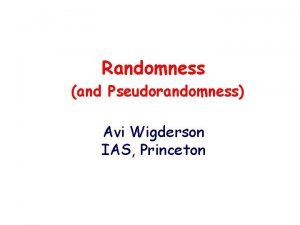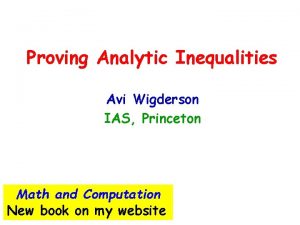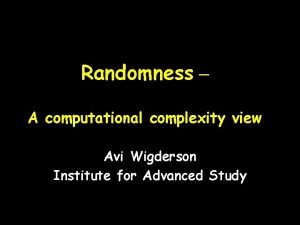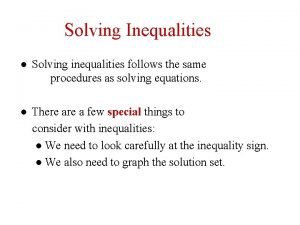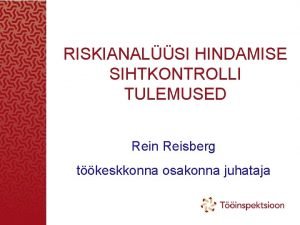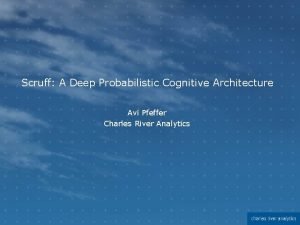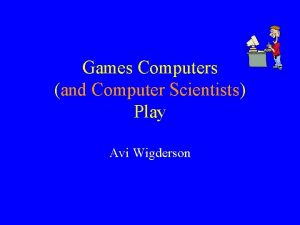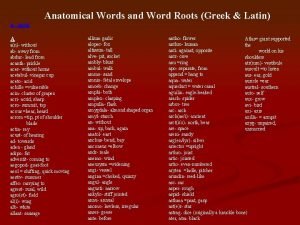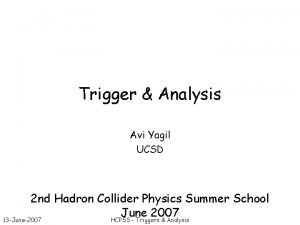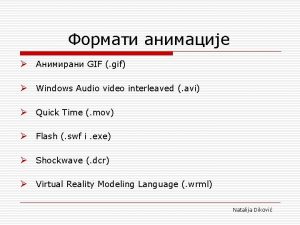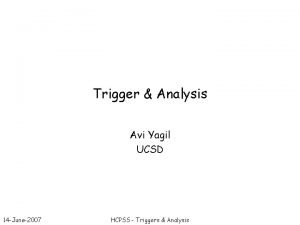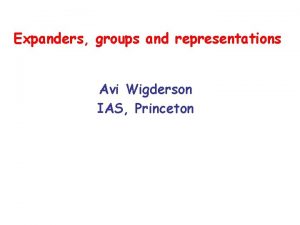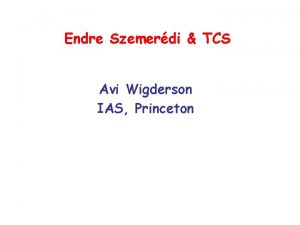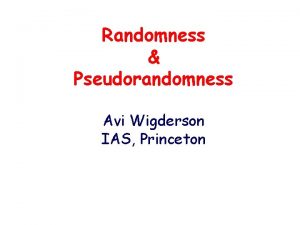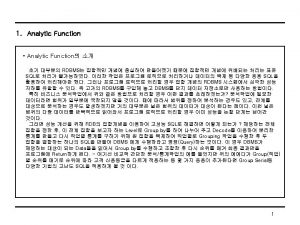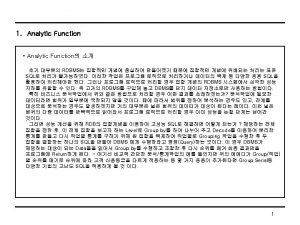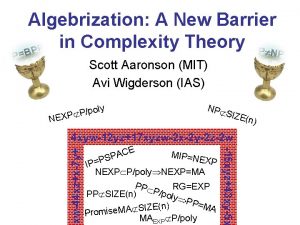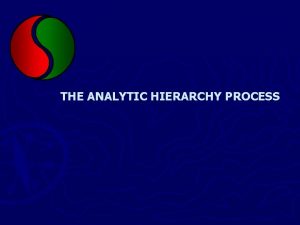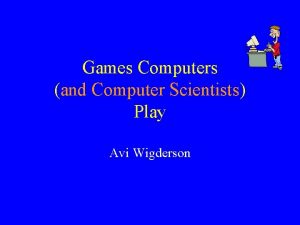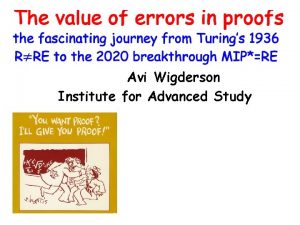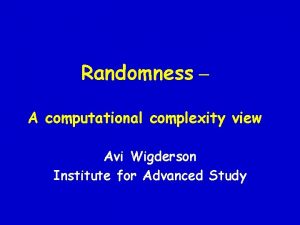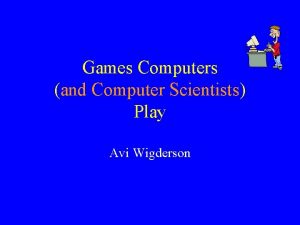Proving Analytic Inequalities Avi Wigderson IAS Princeton Math


![Ubiquity of matrix tuples [GGOW’ 15’ 16] Computational Complexity (A 1, A 2, …, Ubiquity of matrix tuples [GGOW’ 15’ 16] Computational Complexity (A 1, A 2, …,](https://slidetodoc.com/presentation_image_h2/703c430415ca235f8a6c0d5183fe6884/image-3.jpg)
![Brascamp-Lieb Inequalities [BL’ 76, Lieb’ 90] ∫ ∏j fj ≤ C ∏j |fj|pj Propaganda: Brascamp-Lieb Inequalities [BL’ 76, Lieb’ 90] ∫ ∏j fj ≤ C ∏j |fj|pj Propaganda:](https://slidetodoc.com/presentation_image_h2/703c430415ca235f8a6c0d5183fe6884/image-4.jpg)
![Brascamp-Lieb Inequalities [BL’ 76, Lieb’ 90] Input B = (B 1, B 2, …, Brascamp-Lieb Inequalities [BL’ 76, Lieb’ 90] Input B = (B 1, B 2, …,](https://slidetodoc.com/presentation_image_h2/703c430415ca235f8a6c0d5183fe6884/image-5.jpg)


![Cauchy-Schwarz, Holder d=1 f 1, f 2: R R+ [CS] ∫x R f 1(x)f Cauchy-Schwarz, Holder d=1 f 1, f 2: R R+ [CS] ∫x R f 1(x)f](https://slidetodoc.com/presentation_image_h2/703c430415ca235f8a6c0d5183fe6884/image-8.jpg)
![Loomis-Whitney I d=2, x=(x 1, x 2) f 1, f 2: R R+ [Trivial] Loomis-Whitney I d=2, x=(x 1, x 2) f 1, f 2: R R+ [Trivial]](https://slidetodoc.com/presentation_image_h2/703c430415ca235f8a6c0d5183fe6884/image-9.jpg)

![Young I d=2, x=(x 1, x 2) [Young] x 1+x 2 ∫x R 2 Young I d=2, x=(x 1, x 2) [Young] x 1+x 2 ∫x R 2](https://slidetodoc.com/presentation_image_h2/703c430415ca235f8a6c0d5183fe6884/image-11.jpg)
![Young II d=2, x=(x 1, x 2) [Young] f 1, f 2, f 3: Young II d=2, x=(x 1, x 2) [Young] f 1, f 2, f 3:](https://slidetodoc.com/presentation_image_h2/703c430415ca235f8a6c0d5183fe6884/image-12.jpg)
![Brascamp-Lieb Inequalities [BL’ 76, Lieb’ 90] Input B = (B 1, B 2, …, Brascamp-Lieb Inequalities [BL’ 76, Lieb’ 90] Input B = (B 1, B 2, …,](https://slidetodoc.com/presentation_image_h2/703c430415ca235f8a6c0d5183fe6884/image-13.jpg)

![Feasibility: C<∞ [Bennett-Carbery-Christ-Tao’ 08] Input B = (B 1, B 2, …, Bm) Bj: Feasibility: C<∞ [Bennett-Carbery-Christ-Tao’ 08] Input B = (B 1, B 2, …, Bm) Bj:](https://slidetodoc.com/presentation_image_h2/703c430415ca235f8a6c0d5183fe6884/image-15.jpg)
![BL-constant [Lieb’ 90] Input B = (B 1, B 2, …, Bm) Bj: Rn BL-constant [Lieb’ 90] Input B = (B 1, B 2, …, Bm) Bj: Rn](https://slidetodoc.com/presentation_image_h2/703c430415ca235f8a6c0d5183fe6884/image-16.jpg)

![Geometric BL [Ball’ 89, Barthe’ 98] Input B = (B 1, B 2, …, Geometric BL [Ball’ 89, Barthe’ 98] Input B = (B 1, B 2, …,](https://slidetodoc.com/presentation_image_h2/703c430415ca235f8a6c0d5183fe6884/image-18.jpg)
![Alternate Minimization [GGOW’ 16] [B’ 89] (B, p) is geometric if (1) Bj. Bjt Alternate Minimization [GGOW’ 16] [B’ 89] (B, p) is geometric if (1) Bj. Bjt](https://slidetodoc.com/presentation_image_h2/703c430415ca235f8a6c0d5183fe6884/image-19.jpg)






- Slides: 25

Proving Analytic Inequalities Avi Wigderson IAS, Princeton Math and Computation New book on my website

Past 2 lectures Alternate minimization & Symbolic matrices: analytic algorithms for algebraic problems. Polynomial identities: algebraic tools for understanding analytic algorithms. Today Applications: Analysis & Optimization
![Ubiquity of matrix tuples GGOW 15 16 Computational Complexity A 1 A 2 Ubiquity of matrix tuples [GGOW’ 15’ 16] Computational Complexity (A 1, A 2, …,](https://slidetodoc.com/presentation_image_h2/703c430415ca235f8a6c0d5183fe6884/image-3.jpg)
Ubiquity of matrix tuples [GGOW’ 15’ 16] Computational Complexity (A 1, A 2, …, Am): symbolic matrix i. Aixi Quantum Information Theory (A 1, A 2, …, Am): completely positive operator Non-commutative Algebra In P (A 1, A 2, …, Am): rational expression In P (A 1, A 2, …, Am): orbit under Left-Right action In P (A 1, A 2, …, Am): projectors in Brascamp-Lieb inequalities In P (A 1, A 2, …, Am): exp size linear programs In P Invariant Theory Analysis Optimization
![BrascampLieb Inequalities BL 76 Lieb 90 j fj C j fjpj Propaganda Brascamp-Lieb Inequalities [BL’ 76, Lieb’ 90] ∫ ∏j fj ≤ C ∏j |fj|pj Propaganda:](https://slidetodoc.com/presentation_image_h2/703c430415ca235f8a6c0d5183fe6884/image-4.jpg)
Brascamp-Lieb Inequalities [BL’ 76, Lieb’ 90] ∫ ∏j fj ≤ C ∏j |fj|pj Propaganda: special cases & extensions Cauchy-Schwarz, Holder Loomis-Whitney Young’s convolution Lieb’s Non-commutative BL Bennett-Bez Nonlinear BL Precopa-Leindler Nelson Hypercontractive Brunn-Minkowski Barthe Reverse BL Quantitative Helly Analysis, Geometry, Probability, Information Theory, …
![BrascampLieb Inequalities BL 76 Lieb 90 Input B B 1 B 2 Brascamp-Lieb Inequalities [BL’ 76, Lieb’ 90] Input B = (B 1, B 2, …,](https://slidetodoc.com/presentation_image_h2/703c430415ca235f8a6c0d5183fe6884/image-5.jpg)
Brascamp-Lieb Inequalities [BL’ 76, Lieb’ 90] Input B = (B 1, B 2, …, Bm) Bj: Rn Rnj (BL data) p = (p 1, p 2, …, pm) pj ≥ 0 ∫x Rn linear ∏j fj(Bj(x)) ≤ C ∏j |fj|pj ( fj: Rnj R+ integrable ) f = (f 1, f 2, …, fm) [Garg-Gurvits-Oliveira-W’ 16] Feasibility & Optimal C in P (through Operator Scaling & Alternate Minimization) Optimization: solving (some) exponential size LPs

Plan - Examples - General statement - Structural theory - Algorithm - Consequences: Structure Optimization (? ) Notation f: Rd R+ |f|1/p = (∫x Rd f(x)1/p)p

Examples
![CauchySchwarz Holder d1 f 1 f 2 R R CS x R f 1xf Cauchy-Schwarz, Holder d=1 f 1, f 2: R R+ [CS] ∫x R f 1(x)f](https://slidetodoc.com/presentation_image_h2/703c430415ca235f8a6c0d5183fe6884/image-8.jpg)
Cauchy-Schwarz, Holder d=1 f 1, f 2: R R+ [CS] ∫x R f 1(x)f 2(x) ≤ |f 1|2|f 2|2 p 1=p 2=1/2 any other norms? [H] ∫x R f 1(x)f 2(x) ≤ |f 1|1/p 1|f 2|1/p 2 p 1+p 2=1 pi≥ 0
![LoomisWhitney I d2 xx 1 x 2 f 1 f 2 R R Trivial Loomis-Whitney I d=2, x=(x 1, x 2) f 1, f 2: R R+ [Trivial]](https://slidetodoc.com/presentation_image_h2/703c430415ca235f8a6c0d5183fe6884/image-9.jpg)
Loomis-Whitney I d=2, x=(x 1, x 2) f 1, f 2: R R+ [Trivial] ∫x R 2 f 1(x 1)f 2(x 2) = |f 1|1|f 2|1 p 1=p 2=1 x 2 a 2 A a 1 x 1 area(A) ≤len(a 1)len(a 2) H(Z 1 Z 2) ≤ H(Z 1)+H(Z 2)

Loomis-Whitney II d=3, x=(x 1, x 2, x 3) f 1, f 2, f 3: R 2 R+ [LW] ∫x R 3 f 1(x 2 x 3)f 2(x 1 x 3)f 3(x 1 x 2) ≤ |f 1|2|f 2|2|f 3|2 pi=½ x 2 A 23 x 3 A 12 any other norms? x 1 S A 13 H(Z 1 Z 2 Z 2) ≤ ½[H(Z 1 Z 2)+H(Z 2 Z 3)+H(Z 1 Z 3)] vol(S) ≤ [area(A 12)area(A 13)area(A 23)]1/2
![Young I d2 xx 1 x 2 Young x 1x 2 x R 2 Young I d=2, x=(x 1, x 2) [Young] x 1+x 2 ∫x R 2](https://slidetodoc.com/presentation_image_h2/703c430415ca235f8a6c0d5183fe6884/image-11.jpg)
Young I d=2, x=(x 1, x 2) [Young] x 1+x 2 ∫x R 2 f 1(x 1)f 2(x 2)f 3(x 1+2) ≤ (√ 3)/2 |f 1|3/2|f 2|3/2|f 3|3/2 pi=2/3 Any other norms? a 3 a 2 f 1, f 2, f 3: R R+ A a 1 area(A) ≤ (√ 3)/2 [len(a 1)len(a 2)len(a 3)]2/3 x 1
![Young II d2 xx 1 x 2 Young f 1 f 2 f 3 Young II d=2, x=(x 1, x 2) [Young] f 1, f 2, f 3:](https://slidetodoc.com/presentation_image_h2/703c430415ca235f8a6c0d5183fe6884/image-12.jpg)
Young II d=2, x=(x 1, x 2) [Young] f 1, f 2, f 3: R 2 R+ ∫x R 2 f 1(x 1)f 2(x 2)f 3(x 1+2) ≤ C |f 1|1/p 1|f 2|1/p 2|f 3|1/p 3 p 1+p 2+p 3=2 1≥pi≥ 0 C = q 1 q 1 q 2 q 2 q 3 q 3 p 1 p 1 p 2 p 2 p 3 p 3 qi=1 -pi
![BrascampLieb Inequalities BL 76 Lieb 90 Input B B 1 B 2 Brascamp-Lieb Inequalities [BL’ 76, Lieb’ 90] Input B = (B 1, B 2, …,](https://slidetodoc.com/presentation_image_h2/703c430415ca235f8a6c0d5183fe6884/image-13.jpg)
Brascamp-Lieb Inequalities [BL’ 76, Lieb’ 90] Input B = (B 1, B 2, …, Bm) Bj: Rn Rnj (BL data) p = (p 1, p 2, …, pm) pj ≥ 0 ∫x Rn ∏j fj(Bj(x)) ≤ C ∏j |fj|1/pj f = (f 1, f 2, …, fm) ( fj: Rnj R+ integrable ) Given BL data (B, p): Is there a finite C? What is the smallest C? [ BL(B, p) ] [GGOW’ 16] Feasibility & Optimal C in P

Structure (look for similarities to lecture 1)
![Feasibility C BennettCarberyChristTao 08 Input B B 1 B 2 Bm Bj Feasibility: C<∞ [Bennett-Carbery-Christ-Tao’ 08] Input B = (B 1, B 2, …, Bm) Bj:](https://slidetodoc.com/presentation_image_h2/703c430415ca235f8a6c0d5183fe6884/image-15.jpg)
Feasibility: C<∞ [Bennett-Carbery-Christ-Tao’ 08] Input B = (B 1, B 2, …, Bm) Bj: Rn Rnj (BL data) p = (p 1, p 2, …, pm) pj ≥ 0 ∫x Rn ∏j fj(Bj(x)) ≤ C ∏j |fj|1/pj [BCCT’ 08] C<∞ iff p PB P B: fi (the Polytope of B) ∑j p j n j = n ∑j pj dim(Bj. V) ≥ dim(V) subspace V in Rm pj ≥ 0 (Exponentially many inequalities) Rank nondecreasing
![BLconstant Lieb 90 Input B B 1 B 2 Bm Bj Rn BL-constant [Lieb’ 90] Input B = (B 1, B 2, …, Bm) Bj: Rn](https://slidetodoc.com/presentation_image_h2/703c430415ca235f8a6c0d5183fe6884/image-16.jpg)
BL-constant [Lieb’ 90] Input B = (B 1, B 2, …, Bm) Bj: Rn Rnj (BL data) p = (p 1, p 2, …, pm) pj ≥ 0 ∫x Rn ∏j fj(Bj(x)) ≤ C ∏j |fj|1/pj fi [Lieb’ 90] BL(B, p) is optimized when fj are Gaussian 1/cap(L) = BL(B, p)2 = sup ∏j det(Aj)pj Nonconvex Aj>0 det(∑j pj Bjt. Aj. Bj) for some completely positive operator L (B, p) B 1 B 2 Quiver B 3 reduction A 1 A 2 A 3 A 4

Algorithms
![Geometric BL Ball 89 Barthe 98 Input B B 1 B 2 Geometric BL [Ball’ 89, Barthe’ 98] Input B = (B 1, B 2, …,](https://slidetodoc.com/presentation_image_h2/703c430415ca235f8a6c0d5183fe6884/image-18.jpg)
Geometric BL [Ball’ 89, Barthe’ 98] Input B = (B 1, B 2, …, Bm) Bj: Rn Rnj (BL data) p = (p 1, p 2, …, pm) pj ≥ 0 ∫x Rn ∏j fj(Bj(x)) ≤ C ∏j |fj|1/pj fi [B’ 89] (B, p) is geometric if (Projection) B jt = I n j (Isotropy) ∑j p j B j t B j = I n j [B’ 89] (B, p) geometric BL(B, p)=1 Doublystochastic
![Alternate Minimization GGOW 16 B 89 B p is geometric if 1 Bj Bjt Alternate Minimization [GGOW’ 16] [B’ 89] (B, p) is geometric if (1) Bj. Bjt](https://slidetodoc.com/presentation_image_h2/703c430415ca235f8a6c0d5183fe6884/image-19.jpg)
Alternate Minimization [GGOW’ 16] [B’ 89] (B, p) is geometric if (1) Bj. Bjt = Inj (2) ∑j pj Bjt. Bj = In j [Projection property] [Isotropy property] On input (B, p): attempt to make it geometric Repeat t=nc times: - Satisfy Projection (Right basis change) - Satisfy Isotropy (Left basis change) Converges quickly iff (B, p) is feasible [GGOW’ 16] - Feasibility (testing C<∞, p PB) in polynomial time - Weak separation oracle - Feasible (B, p) converges to geometric in polytime - Keeping track of changes approximates BL(B, p) - Structure: bounds & continuity of BL(B, p), LP bounds.

Optimization

Linear programming & Polytopes e 3 P = conv {0, e 1, e 2, … em} Rm e 2 = { p Rm: ∑j pj ≤ 1 pj ≥ 0 j [m] } 0 Membership Problem: Test if p P? e 1 Easy if P has few inequalities, in a large variety of settings with many inequalities, and when… [GGOW’ 16] P is a BL-polytope! B = (B 1, B 2, …, Bm) Bj: Rn Rnj PB: { p Rm: ∑j pj nj = n ∑j pj dim(Bj. V) ≥ dim(V) V ≤ Rn pj ≥ 0 ? ? Applications? ?

Optimization: linear programs with exponentially many inequalities BL polytopes capture Matroids M = {v 1, v 2, …… vm} vj Rn Exponentially many Inequalities VJ = {vj : j J} PM = conv {1 J: VJ is a basis} Rm = { p Rm: ∑j�J pj ≤ dim(VJ) J [m] pj ≥ 0 Bj: Rn R Bjx=<vj, x> [Fact] PB = PM j [m] } j [m]

Optimization: linear programs with exponentially many inequalities BL polytopes capture Matroid Intersection M = {v 1, v 2, …… vm} vj Rn N = {u 1, u 2, …… um} uj Rn PM, N = conv {1 J: VJ, UJ are bases} Rm [Edmonds] = {p Rm: ∑j pj ≤ dim(VJ) J [m] ∑j pj ≤ dim(UJ) J [m] pj ≥ 0 Bj: R 2 n R 2 Bjx=<vj, x. L>, <uj, x. R> [Vishnoi] PB = PM, N j [m] } j [m]

Optimization: linear programs with exponentially many inequalities General matching as BL polytopes? ? G = (V, E) |V|=2 n, |E|=m PG = conv {1 S: S E perfect matching} Rm [Edmonds] = {p Rm: ∑ij E pij =n ∑ i S j S pij ≥ 1 S V odd pij ≥ 0 ij E } Is this a BL-polytope? Other nontrivial examples? Optimization?

Summary One problem : Singularity of Symbolic Matrices One algorithm: Alternating minimization Non-commutative Algebra: Word problem Invariant Theory: Nullcone & orbit problems Quantum Information Theory: Positive operators Analysis: Brascamp-Lieb inequalities Optimization Exponentially large linear programs Computational complexity VP=VNP? Tools, applications, structure, connections, … Optimization, Complexity & Invariant Theory IAS workshop, June 4 -8, 2018
 Avi wigderson princeton
Avi wigderson princeton Avi wigderson
Avi wigderson Avi wigderson
Avi wigderson Avi wigderson
Avi wigderson Avi wigderson
Avi wigderson Math inequalities
Math inequalities Nothing but the truth plot diagram
Nothing but the truth plot diagram Vttes
Vttes Hero avi
Hero avi Sup.avi
Sup.avi Ragweed by avi lesson plans
Ragweed by avi lesson plans Império avi
Império avi Avi pfeffer
Avi pfeffer Nothing but the truth theme
Nothing but the truth theme Avi finance shared services
Avi finance shared services Losing alice avi
Losing alice avi Latin anatomy words
Latin anatomy words Luclia
Luclia Avi lior
Avi lior Avi yagil ucsd
Avi yagil ucsd Kari lehtola avi
Kari lehtola avi Uusimaa avi
Uusimaa avi Audio video interleaved
Audio video interleaved Avi freedman
Avi freedman Avi yagil
Avi yagil Advantages of avi
Advantages of avi
